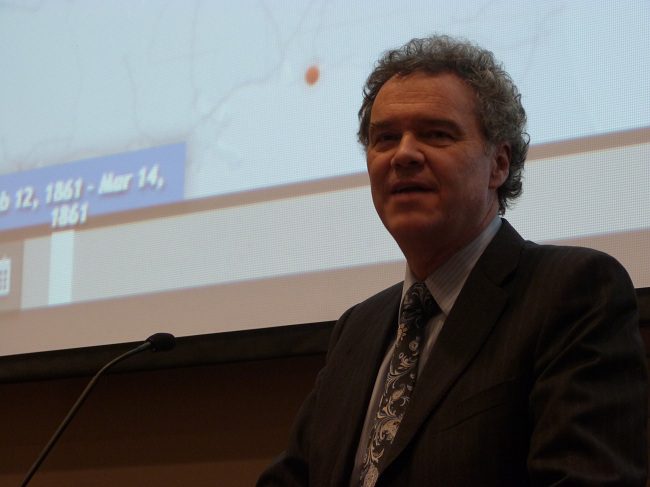Viewing emancipation through a digital lens

JANUARY 24, 2013
by Sara Morano ’13, Contributing Writer
“It took many hands to loosen the chains of slavery and many on accident.”
Edward Ayers, an American historian and the president of the University of Richmond, spoke about emancipation to a crowd that filled Shaw Hall of the Younts Conference Center on Tuesday night.
He was visiting campus amid a “busy season for Civil War historians” like himself; the early part of this year when the January 1st sesquicentennial anniversary of the Emancipation Proclamation is still being commemorated.
Ayers’ lecture was the keystone event for Furman’s commemoration of emancipation; the Freedom Stories series and digital project led by the History Department with the guidance of Professor Lloyd Benson.
“Where did freedom come from?” and “Who brings freedom?” drove Ayers’ mid-week presentation on emancipation. His “car-crash” theory of history underpinned the answers he gave.
As the university president explained to a small group of students that dined with him before his public lecture, history must be approached with the same diligence one would use to explain a car crash.
As Ayers’ comparison goes, a car crash can usually be attributed to more than one cause; it was raining, the roads were slippery, the windows were foggy, the car brakes were bad and the driver had been drinking.
If multiple causes are appropriate to explain simple accident, then, Ayers argues, “to say, ‘Slavery caused the Civil War’ is a bad answer.” Thus, he explains, an incident like the Civil War that spanned four years and involved millions, is the product of thousands of individuals choices actions and causes.
Of course, this approach has its challenges. Putting together all these pieces is a difficult intellectual puzzle. The full picture is hard to create in a single thesis or book. Thus, innovative digital history practices have been useful to Ayers’ study of the Civil War and emancipation.
“We made this because we can’t wrap our mind around something that size,” said Ayers of his university’s online accessible, “Visualizing Emancipation” map.
Ayers demonstrated to his audience how the interactive program plots key events in the Civil War and emancipation. As users clicks through the map, they are able to search types of events, as well as sort their dates by time and place.
Following the blue and red dots, representing advancing armies and emancipated slaves, respectively, showed the relationship between many choices and events in real time.
Comprehensive digital sources allowed Ayers to support the following conclusions.
Competent confederate generals like Robert E. Lee and Stonewall Jackson, who defended Richmond from an early siege by the union army, were necessary to the story of emancipation because they “forced the war to go long enough that the union realized they must end slavery to end the war.”
In addition, a digitized version of the Virginia Secession Convention allowed Ayers to cite the frequency of words like “tariff,” “slavery” and “states’ rights” in the hundreds of pages of debate.
Virginia’s secession debates said little about defending states’ rights but much about defending slavery.
“History has to be understood on all these levels,” Ayers said of his various findings, “to see how all the pieces fit together in time. There is no more important story to understand than emancipation.”
With the last audience question of the night, Ayers considered the immediate repercussions of emancipation and the brutal legacy slavery has imposed even having ended 150 years ago. He concluded this, “It was terrible …. the end of slavery matters. Something precious was won with the end of slavery.”